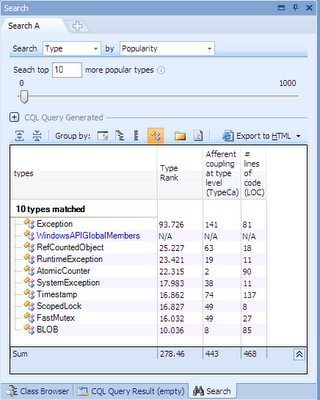The POCO C++ Libraries are a collection of open source class libraries for developing network-centric, portable applications in C++.
POCO stands for POrtable COmponents. The libraries cover functionality such as threads, thread synchronization, file system access, streams, shared libraries and class loading, sockets and network protocols (HTTP, FTP, SMTP, etc.), and include an HTTP server, as well as an XML parser with SAX2 and DOM interfaces and SQL database access.
The modular and efficient design and implementation makes the POCO C++ Libraries well suited for embedded development.
Let’s take a look inside POCO using CppDepend and discover some facts about its implementation and design.
POCO Implementation
Number of line of code
Methods with many number of line of code are not easy to maintain and understand, let’s search for methods with more than 60 lines.


Less than 1% of methods has more than 60 lines.
Cyclomatic Complexity
Cyclomatic complexity is a popular procedural software metric equal to the number of decisions that can be taken in a procedure.
Let’s execute the following CQLinq request to detect methods to refactor.


So only 1% of methods can be considered as complex.
Which methods are complex and not enough commented?


Methods with many variables
Methods where NbVariables is higher than 8 are hard to understand and maintain. Methods where NbVariables is higher than 15 are extremely complex and should be split in smaller methods (except if they are automatically generated by a tool).


Only 8 methods has too many variables.
Types with many methods and fields


Only 3% of types has many methods.
And we can do the same search for fields


Less than 1% of types has many fields.
We can say that POCO is well implemented,few methods are considered complex,the types are simple with few methods and fields and it’s well commented.
DESIGN
Abstract vs instability
The “Abstractness vs Instability” graph can be useful to detect projects that will be difficult to maintain or evolve.
This following post describe the utility of this graph and how to exploit it to improve the design.
For POCO here’s the “Abstractness vs Instability” graph:

Only Fondation is inside the zone of pain , it’s normal because it’s very used by other projects.
Inheritance
Multiple inheritane increase complexity ,and we have to use it carefully.
Let’s search for class with many base classes.

The blue rectangles represent the result.

only few classes derived from more than one class.
Type cohesion
The single responsibility principle states that a class should have more than one reason to change. Such a class is said to be cohesive. A high LCOM value generally pinpoints a poorly cohesive class. There are several LCOM metrics. The LCOM takes its values in the range [0-1]. The LCOMHS (HS stands for Henderson-Sellers) takes its values in the range [0-2]. Note that the LCOMHS metric is often considered as more efficient to detect non-cohesive types. LCOMHS value higher than 1 should be considered alarming.


Only 1% of types are considered as no cohesive.
Efferent coupling
The Efferent Coupling for a particular type is the number of types it directly depends on.
Types where TypeCe > 50 are types that depends on too many other types. They are complex and have more than one responsability. They are good candidate for refactoring.
Let’s execute the following CQLinq request.

And the result is empty so no class has many responsibilities.
Types most used
It’s very interesting to know which types are most used,for that we can use the TypeRank metric.
TypeRank values are computed by applying the Google PageRank algorithm on the graph of type’s dependencies. A homothety of center 0.15 is applied to make it so that the average of TypeRank is 1.
Types with high TypeRank should be more carefully tested because bugs in such types will likely be more catastrophic.

Let’s search for types most used and complex.

The result is empty so no class is very used and complex.
Layering and level metric
This post explain the level metric and how to exploit it to improve design.
Let’s search dependency cycles for that we can execute the following CQLinq request:


Only few methods has dependency cycle, let’s take for example the Zip project and look to its dependency graph.

Only 1 dependency cycle exist in this project.
As conclusion Poco is also well designed, it’s high cohesive and low coupled.